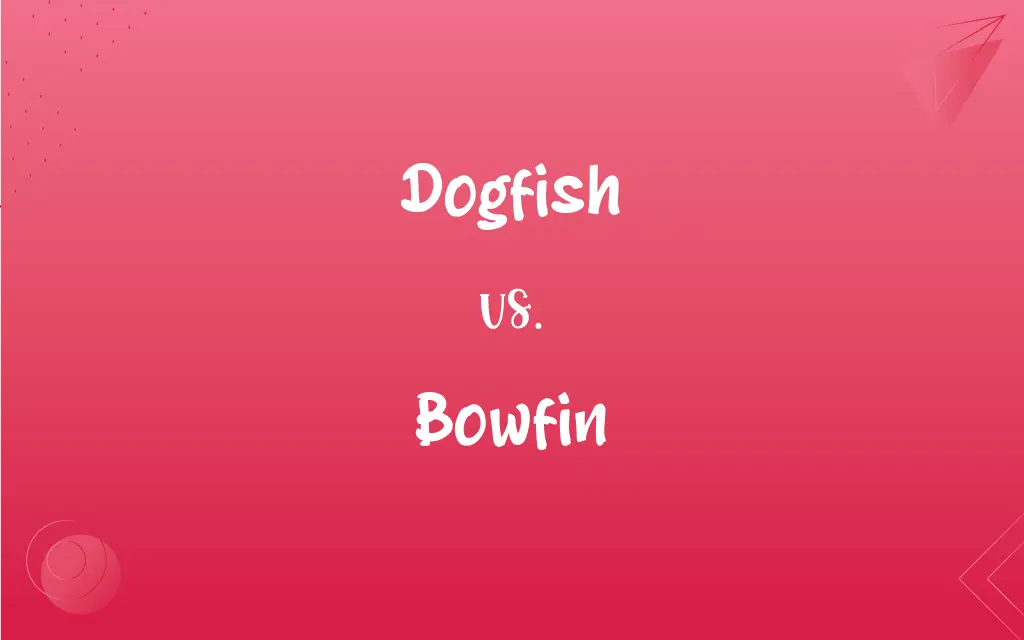Dogfish vs. Bowfin: What's the Difference?
By Aimie Carlson || Updated on May 29, 2024
Dogfish are small, shark-like fish found in saltwater, known for their schooling behavior, while bowfin are freshwater fish with a long dorsal fin and a reputation for being resilient and aggressive.

Key Differences
Dogfish, specifically the spiny dogfish, are small, shark-like fish typically found in saltwater environments such as the Atlantic and Pacific Oceans. They are known for their sharp spines and schooling behavior, often traveling in large groups. Bowfin, on the other hand, are freshwater fish native to North America, particularly the Mississippi River basin and the Great Lakes. They are known for their long dorsal fin that runs most of their back and their ability to breathe air, allowing them to survive in low-oxygen waters.
While dogfish are more commonly associated with marine ecosystems and have features typical of sharks, bowfin are adapted to freshwater habitats and are considered living fossils due to their primitive characteristics.
Dogfish are important to commercial fisheries but are often regarded as a nuisance by fishermen due to their tendency to get caught in nets. In contrast, bowfin are often targeted by sport fishermen for their fight and resilience.
Comparison Chart
Habitat
Saltwater (oceans)
Freshwater (rivers, lakes)
Skeleton Type
Cartilaginous
Bony
ADVERTISEMENT
Notable Features
Sharp spines, schooling behavior
Long dorsal fin, air-breathing ability
Common Regions
Atlantic and Pacific Oceans
North America (Mississippi River, Great Lakes)
Behavior
Travel in large groups
Aggressive and resilient
Commercial Importance
Used in fisheries
Targeted by sport fishermen
Evolutionary Status
Modern species
Living fossil
ADVERTISEMENT
Dogfish and Bowfin Definitions
Dogfish
A small, shark-like fish found in saltwater, known for sharp spines.
The spiny dogfish are often seen swimming in large schools near the coast.
Bowfin
A freshwater fish with a long dorsal fin and a bony skeleton.
Bowfin are easily recognized by their long, undulating dorsal fin.
Dogfish
A member of the shark family with a cartilaginous skeleton.
Dogfish are frequently caught unintentionally by commercial fishermen.
Bowfin
A fish native to North American rivers and lakes, capable of air-breathing.
The bowfin can survive in oxygen-poor waters due to its ability to gulp air.
Dogfish
A fish commonly found in both the Atlantic and Pacific Oceans.
The dogfish population is abundant in the cold waters of the North Atlantic.
Bowfin
A popular target among sport fishermen.
The bowfin's aggressive behavior makes it a popular choice for sport fishing in freshwater.
Dogfish
Marine species known for their distinctive appearance and behavior.
Dogfish have a streamlined body and pointed snout typical of sharks.
Bowfin
Known for their resilience and aggressive nature.
Anglers often find bowfin to be a challenging catch due to their fight and tenacity.
Dogfish
A species used in various fishery industries.
Dogfish are processed for their meat and liver oil.
Bowfin
Often referred to as living fossils due to their primitive characteristics.
Bowfin have changed little over millions of years, earning them the title of living fossils.
Dogfish
Any of various small sharks chiefly of the family Squalidae, often occurring in large schools.
Bowfin
A freshwater fish (Amia calva) of central and eastern North America, having a large mouth and a long dorsal fin, and producing roe that is sometimes used for caviar. Also called dogfish, mudfish; also called regionally choupique.
Dogfish
See bowfin.
Bowfin
A voracious ganoid fish, Amia calva, the last survivor of the order Amiiformes, found in the fresh waters of the United States.
Dogfish
Any of various small sharks
Bowfin
A voracious ganoid fish (Amia calva) found in the fresh waters of the United States; the mudfish; - called also Johnny Grindle, and dogfish.
Dogfish
Especially those from the family Squalidae
Bowfin
Primitive long-bodies carnivorous freshwater fish with a very long dorsal fin; found in sluggish waters of North America
Dogfish
A catshark, any shark from family Scyliorhinidae
Dogfish
A kitefin shark, any shark from family Dalatiidae
Dogfish
(UK) Scyliorhinus canicula or Scyliorhinus stellaris
Dogfish
(Azores Is.) Scyliorhinus canicula
Dogfish
(Canada) Squalus suckleyi
Dogfish
(Bermuda) Mustelus canis
Dogfish
(Barbados) Bodianus rufus
Dogfish
(Guyana) Ginglymostoma cirratum or Mustelus canis
Dogfish
(Trinidad and Tobago) Ginglymostoma cirratum
Dogfish
(Namibia) Squalus acanthias, Squalus blainville, Squalus megalops, or Squalus mitsukurii
Dogfish
(US) The bowfin, Amia calva.
Dogfish
A small shark, of many species, of the genera Mustelus, Scyllium, Spinax, etc.
Dogfish
The bowfin (Amia calva). See Bowfin.
Dogfish
The burbot of Lake Erie.
Dogfish
Primitive long-bodies carnivorous freshwater fish with a very long dorsal fin; found in sluggish waters of North America
Dogfish
Any of several small sharks
FAQs
What is a dogfish?
A dogfish is a small, shark-like fish found in saltwater environments.
Why are bowfins called living fossils?
Bowfins are called living fossils because they have primitive features that have remained unchanged for millions of years.
Where do bowfins live?
Bowfins live in freshwater habitats, such as rivers and lakes in North America.
Do dogfish have bony skeletons?
No, dogfish have cartilaginous skeletons.
Can bowfins breathe air?
Yes, bowfins can breathe air, allowing them to survive in low-oxygen waters.
What are the notable features of dogfish?
Dogfish are known for their sharp spines and schooling behavior.
What makes bowfins unique among freshwater fish?
Bowfins are unique due to their long dorsal fin and ability to breathe air.
Do bowfins have a cartilaginous skeleton?
No, bowfins have a bony skeleton.
Are dogfish solitary?
No, dogfish often travel in large schools.
In which oceans are dogfish commonly found?
Dogfish are commonly found in the Atlantic and Pacific Oceans.
What is a key characteristic of bowfins?
A key characteristic of bowfins is their long dorsal fin that runs most of their back.
Are bowfins aggressive?
Yes, bowfins are known for their aggressive behavior, especially when caught.
Do fishermen target dogfish?
Dogfish are often caught unintentionally but are used in commercial fisheries.
Are dogfish used in fisheries?
Yes, dogfish are used in various fishery industries for their meat and liver oil.
What regions do bowfins inhabit?
Bowfins inhabit the Mississippi River basin and the Great Lakes region.
Do dogfish travel alone or in groups?
Dogfish typically travel in large groups.
What type of fish are dogfish classified as?
Dogfish are classified as a type of shark.
How do bowfins survive in low-oxygen environments?
Bowfins can gulp air, allowing them to survive in low-oxygen environments.
Are dogfish found in freshwater?
No, dogfish are found in saltwater environments.
Why do sport fishermen target bowfins?
Sport fishermen target bowfins for their aggressive behavior and challenge in catching.
About Author
Written by
Aimie CarlsonAimie Carlson, holding a master's degree in English literature, is a fervent English language enthusiast. She lends her writing talents to Difference Wiki, a prominent website that specializes in comparisons, offering readers insightful analyses that both captivate and inform.































































